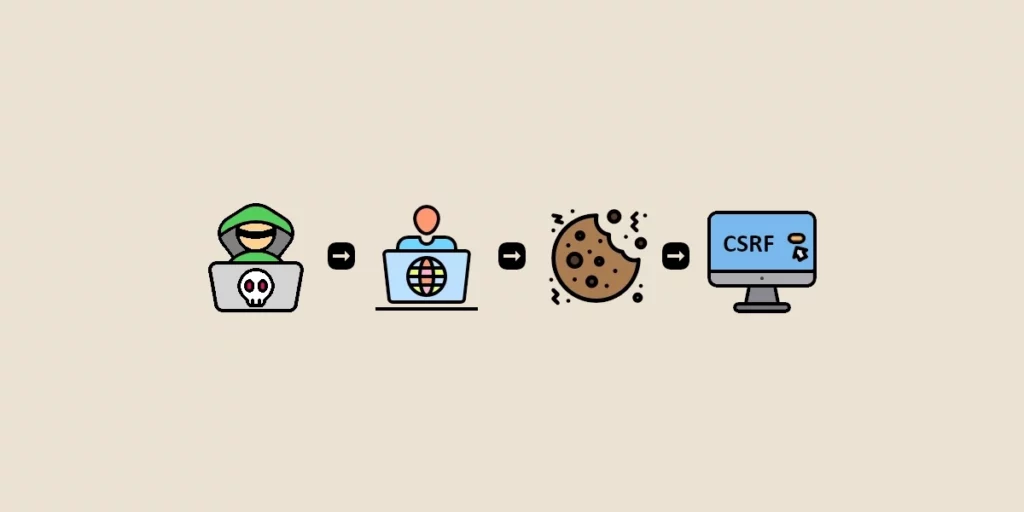CSRF (Cross-site request forgery) or cross-site request forgery is a type of cyberattack. It involves exploiting a user’s active session to send malicious requests without their knowledge. Learn how it functions, its dangers, and ways to safeguard yourself!
Imagine unknowingly, while innocently browsing your favorite site, you authorize a bank transaction or alter your personal settings on another site where you are logged in. Frightening, isn’t it?
This is precisely the kind of mishap that Cross-Site Request Forgery (CSRF) can cause. This stealthy attack exploits the trust that websites place in your browser, turning you into an unintentional accomplice…
A vulnerability
For a cybercriminal, a cross-site request forgery means tricking an authenticated user into performing unwanted actions on a web application where they are logged in. Simply put, the hacker takes advantage of the user’s active session to send malicious requests without them knowing. To better understand, let’s consider a concrete example.
Suppose you are logged into your online bank account. Meanwhile, you visit another compromised or malicious website. Unbeknownst to you, this site might contain a hidden script that sends a request to your bank to transfer money to the attacker’s account.
Since you are already authenticated, the bank assumes the request is legitimate and executes it. This is the entire danger of CSRF, which exploits the trust established between the user’s browser and the targeted website.
Unlike other attacks, such as Cross-Site Scripting (XSS), which require the injection of malicious code into the victim site, CSRF simply hijacks the permissions already granted to the user! For any web developer concerned with the security of their users, understanding and protecting against CSRF is therefore crucial.

How do hackers exploit the trust of websites?
CSRF operates by exploiting the trust that a website places in the user’s browser. When the user is authenticated to a site, their browser stores authentication information, typically in the form of cookies.
These cookies are automatically included in subsequent HTTP requests to the same site, allowing for smooth navigation without requiring constant reauthentication. However, this convenience presents a vulnerability. An attacker can craft a malicious webpage containing disguised requests aimed at the site where the user is authenticated.
If the user visits this page while logged into the target site, their browser, innocently, will send the request with the authentication cookies. The target site will then receive a seemingly legitimate request from the authenticated user, executing the action without the user’s consent!
For example, an attacker could insert an invisible image in a webpage: “<img src=”http://bank.example.com/transfer?account=attacker&amount=1000″ alt=”Transfer in progress”>”. If a user authenticated on “bank.example.com” visits this page, their browser will interpret the <img> tag and send a request to the bank’s site to transfer 1,000 monetary units to the attacker’s account, all without the user even noticing!
What can hackers do with a CSRF?
Cybercriminals can use CSRF attacks for a variety of purposes. For instance, an attacker may send a user a link via email urging them to click on it. However, this link might contain a request changing the user’s password on a site where they are authenticated, thereby gaining access to the victim’s account.
Furthermore, as mentioned earlier, a user logged into their online bank account might visit a webpage containing a script initiating a transfer from their account to the attacker’s account.
Another possibility is to force a user to change the email address associated with their account on an online service. Once the address is changed, the attacker can use the “forgot password” feature to reset the password and take control of the account.
These different examples demonstrate the diversity of CSRF attacks and accentuate the importance of deploying appropriate protective measures to ensure the security of online users.

Techniques and prevention methods
Fortunately, several effective strategies can protect against CSRF attacks. The Synchronizer Token Pattern involves embedding a unique and random token in every form or request that is likely to alter data.
This anti-CSRF token, generated server-side, is verified with every received request. If the token is absent or incorrect, the request is rejected. This technique is widely recommended for its robustness. Another approach is the use of the SameSite attribute for cookies. It instructs the browser not to send the cookie during cross-site requests.
By setting this attribute to “Strict” or “Lax”, the risks that session cookies will be included in requests originating from other sites are limited. This prevents certain CSRF attacks. Additionally, the server can verify the origin of requests by examining the “Referer” or “Origin” headers. If the origin does not match the expected domain, the request is refused.
However, although this method adds a layer of security, it can be bypassed and should not serve as the sole protection. Nonetheless, despite these protective measures, insufficient knowledge of CSRF threats and prevention methods results in vulnerable applications. It is vital to train development teams in web security best practices!
Top tools and frameworks for protection
Many modern frameworks natively integrate CSRF attack protections. It is, however, important to ensure these protections are properly configured and enabled in your projects.
The renowned Python framework, Django, for instance, includes built-in protection against CSRF attacks. With a specific middleware and template tags, Django automatically generates CSRF tokens for each form and hence ensures a systematic verification of requests.
On the PHP side, Laravel also provides integrated CSRF protection. Each form automatically includes a CSRF token, and the framework verifies these tokens during form submissions. As a result, any unauthenticated request is blocked.
For security testing, a must-have tool is Burp Suite. It allows for HTTP request analysis, detection of potential vulnerabilities, including CSRF flaws, and assessment of the effectiveness of protections in place.
Also noteworthy is the open-source project OWASP CSRFGuard, which provides a Java library implementing protections against CSRF attacks. It offers an additional layer of security by generating unique tokens for each user session.
The adoption of these tools and frameworks facilitates the implementation of robust protection measures against CSRF attacks, while also simplifying the process for developers.

CSRF, a cyberattack as insidious as it is dangerous
As online interactions become ubiquitous, the security of web applications is more than ever a priority. CSRF attacks, though discreet, can have devastating consequences for users and businesses. It is therefore essential to adopt a proactive approach to security.
By integrating anti-CSRF protections from the early stages of development, relying on secure frameworks, and continuously educating teams on best practices, developers can significantly reduce risks associated with these vulnerabilities. Constant vigilance, coupled with the use of appropriate tools, constitutes the best defense against these insidious threats.
To learn how to thwart CSRF and various types of cyberattacks, you can choose DataScientest. Our assortment of training programs will equip you with the skills needed to become an analyst, administrator, consultant, or cybersecurity engineer.
Thanks to our practice-oriented pedagogy, you can develop genuine expertise and earn a state-recognized diploma along with professional certification. We also offer developer training that emphasizes cybersecurity, enabling you to create websites and web applications protected against attacks.
All our training courses can be completed remotely in BootCamp, alternating, or continuous formats, with our organization eligible for funding via CPF or France Travail. Discover DataScientest!
Now you know all about CSRF cyber attacks. For more information on the same subject, take a look at our dossier on XSS attacks, and our general dossier on cyber attacks.










